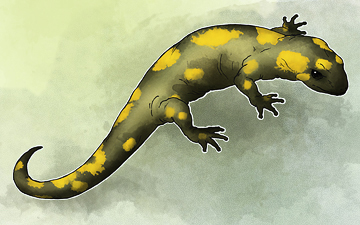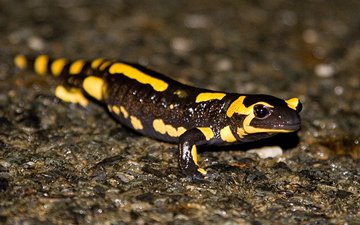The Fire Salamander (Salamandra salamandra) is probably the best-known salamander species in Europe. It is black with yellow spots or stripes to a varying degree; some specimens can be nearly completely black while on others the yellow is dominant. Shades of red and orange may sometimes appear, either replacing or mixing with the yellow according to subspecies. Fire Salamanders can have a very long lifespan. A salamander lived for more than 50 years in Museum Koenig, a German natural history museum.
Fire Salamanders live in forests in the hilly parts of southern and central Europe. They prefer deciduous forests, as they like to hide in the fallen leaves, but also at mossy tree trunks. They need clean small brooks in their habitat for the development of the larvae. Whether on land or in water, fire salamanders are inconspicuous. They spend much of their time hidden beneath stones, wood or other objects.
Fire Salamanders are active in the evening and the night, but on rainy days they are active in daytime as well. Their diet consists of various insects, spiders, earthworms and slugs, but they also occasionally eat small vertebrates like newts and young frogs. Small prey will be caught within the range of the vomerine teeth or by the posterior half of the tongue, which adheres the prey. The fire salamander can grow to around 8 inches.
It is possible that the name of the species derives from old tales of these amphibians: the salamanders hide within holes and crevasses in damp wood and tree trunks. When humans cut down wood to use for heating, the salamanders often remained hidden within. When a fire was lit, the heat forced the animals to leave the wood and crawl to safety, because of this they appear as though they were “crawling from within the flames”.
(From Wikipedia, May 14th, 2010)
– – –
Tail cylindrical, shorter than body with head. Conspicuous parotoid glands behind eyes are pigmented. Dorsal and lateral skin black, with large yellow to orange spots and/or bands. Yellow pattern varies among subspecies, although it is not entirely reliably for subspecies identification. Belly skin black or brownish. Females generally larger than males and possess relatively shorter extremities and tail. Male’s cloaca much more swollen than female’s cloaca. Size: up to 250 mm, sometimes almost 300 mm.
(From EOL via Amphibiaweb)
– – –





